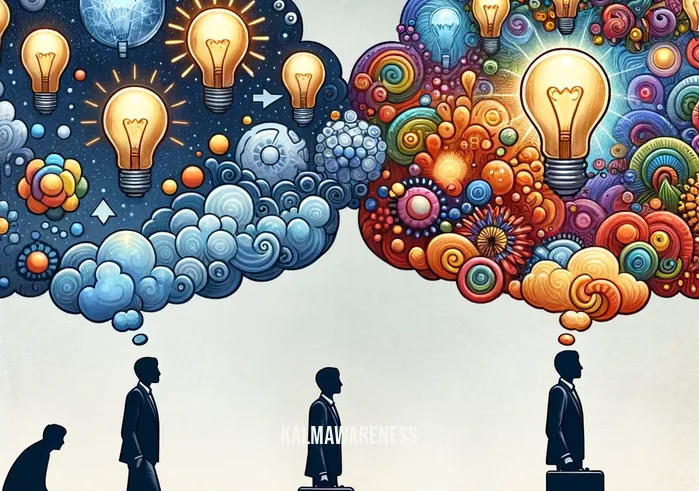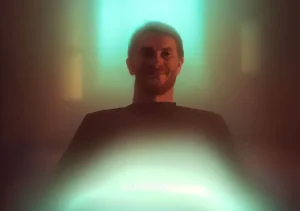Are Our Thoughts Truly Our Own? An Exploration into the Nature of Thought
The human mind is a marvel of evolution, a sophisticated machine capable of complex reasoning, pattern recognition, and abstract thought. It is our most intimate companion, responsible for our perceptions, decisions, and interactions. But one of the most mystifying and fundamental questions we grapple with is: are our thoughts our own? This question isn’t just philosophical; it is deeply personal. It’s an inquiry into self-awareness, our sense of autonomy, and the very nature of consciousness itself. In this comprehensive exploration, we will delve deep into the realms of thought ownership, tracing its origins, understanding its patterns, and uncovering its intimate relationship with the self. Contemplating the Nature of Thoughts will be the beacon guiding our journey.
The Ephemeral Nature of Thoughts
Thoughts, fleeting and transient, drift in and out of our awareness, often without our conscious control. While some thoughts are a direct result of our sensory experiences, others seem to arise spontaneously from the depths of our subconscious. One moment we’re pondering what to eat for dinner, and the next, we’re reminiscing about a distant memory or concocting elaborate fantasies. This ephemerality poses the question: if our thoughts can be so arbitrary and independent, can we truly claim ownership of them?
External Influences on Our Thoughts
Every day, our minds are bombarded by a myriad of external stimuli—conversations, media, culture, societal norms, and myriad other factors. These elements play a significant role in shaping our thoughts. Take, for instance, the exposure to news and media. The information we consume, and the manner in which it’s presented, can sway our opinions, influence our beliefs, and even alter our perceptions of reality. Given this pervasive external influence, the question becomes even more pronounced: are your thoughts your own?
Mindfulness: The Key to Unlocking Thought Ownership
One powerful tool in our journey of introspection is mindfulness—a deliberate, non-judgmental focus on the present moment. By cultivating an awareness of our thought patterns, we can begin to discern which thoughts genuinely originate from our core beliefs and which are the byproducts of external influences. The practice of Breathing and Meditation can further enhance this clarity, allowing us to delve deep into our minds, stripping away the layers of external conditioning and reaching the authentic self beneath.
“To understand the immeasurable, the mind must be extraordinarily quiet, still.”
- Jiddu Krishnamurti
The Journey Ahead
As we embark on this quest of understanding, it’s essential to approach it with an open mind and a willingness to challenge long-held beliefs. Recognizing that thoughts are multifaceted constructs influenced by myriad factors—both internal and external—is the first step in this enlightening journey.
In the subsequent segments, we’ll dive deeper into the intricacies of thought ownership, exploring its origins and examining how we can cultivate a keen awareness of our mental processes. We’ll further delve into the profound relationship between the self and thoughts, drawing connections, dispelling myths, and offering insights that can fundamentally transform our understanding of ourselves.
The landscape of the mind is vast and intricate, and the exploration of its terrains is bound to be profound and transformative. As we navigate this complex tapestry, one thread remains constant—the quest for self-awareness and understanding. And in this pursuit, the key question that will guide us is: are our thoughts truly our own?
For those eager to continue this exploration and delve deeper into the mysteries of thought and consciousness, I invite you to journey with us in the next segment, where we’ll further explore this captivating realm. Continue reading to uncover more insights and revelations about the enigmatic world of our minds.

The Mosaic of Mind: Delving into the Source of Our Thoughts
Every crevice of the human psyche holds mysteries waiting to be uncovered. As we deepened our understanding of the question, “are our thoughts our own?”, a more nuanced perspective emerges. While the previous segment laid the foundation, this chapter delves into the intricate layers of thoughts, their sources, and their manifestations.
Factors Shaping Our Thoughts
Our thoughts are not formed in isolation. A combination of intrinsic and extrinsic factors come together in a symphony, leading to every individual thought we experience. Some of the predominant influences include:
- Personal Experiences: Past traumas, joyful moments, and daily interactions heavily influence our cognitive processes.
- Cultural Background: Our upbringing and cultural milieu determine a significant portion of our worldview.
- Genetic Predisposition: Our DNA carries memories and predispositions, affecting our temperament and thought patterns.
- Educational Exposure: The kind of knowledge we’re exposed to and the way we’re educated can drastically shape our thinking.
- Social Interactions: Daily exchanges, relationships, and social dynamics impact our opinions, beliefs, and reflections.
The Interplay of Emotion and Cognition
Our emotional states are intrinsically linked to our thoughts. When we’re elated, our thoughts tend to be optimistic. Conversely, during melancholic phases, our thinking might lean towards the pessimistic end. But how do various emotional states influence the nature of our thoughts?
| Emotional State | Type of Thought | Potential Outcome |
|---|---|---|
| Happiness | Optimistic, hopeful, and forward-looking | Enhanced creativity |
| Sadness | Reflective, introspective, and cautious | Depth in analytical thinking |
| Anger | Reactive, aggressive, and confrontational | Quick decision making |
| Fear | Defensive, anxious, and risk-averse | Heightened alertness |
| Calmness | Balanced, rational, and holistic | Well-informed choices |
Thoughts: Constructed or Innate?
If you’ve ever found yourself questioning the origin of a particular thought, you’re not alone. Thoughts can seem so intrinsic to our being, yet so foreign at the same time. Some believe our thoughts are constructed over time, shaped by experiences and environments. Others argue for an innate origin, suggesting thoughts are preordained or determined by our very nature. Perhaps, it’s a mix of both, a delicate balance of destiny and development.
The Ever-evolving Nature of Thought
While our thoughts are shaped by myriad factors, they aren’t set in stone. They’re fluid, ever-changing, and malleable. Personal growth, new experiences, and shifts in perspective can lead to evolution in our thought patterns. As we journey through life, we must remain open to this evolution, embracing change and remaining receptive to new ideas.
“The mind is not a vessel to be filled, but a fire to be kindled.”
– Plutarch
Looking Ahead: The Boundaries of Thought
Our journey into understanding whether our thoughts are truly our own has only just begun. As we’ve unraveled the factors influencing our thinking and the interplay between emotion and cognition, it’s evident that the question is multifaceted. But where do we draw the line? What are the boundaries of thought? Are there thoughts that are universally experienced by all, transcending the confines of individual experiences and backgrounds?
As we gear up to delve deeper in the next chapter, we’ll explore these boundaries, challenge our understanding, and seek answers to these intriguing questions. So, for those hungry for more insights into the realm of cognition and consciousness, I encourage you to continue reading and embark on yet another enlightening journey with us.

Discovering Luminosity: How Our Thoughts Illuminate Our Path
As we journey deeper into understanding the enigma surrounding the question, “are our thoughts our own?”, there’s an undeniable aspect that deserves our attention: the power of thoughts to inspire and provide hope. Our thoughts aren’t just cognitive responses; they’re a beacon of light, guiding us through life’s darkest tunnels. In this chapter, we’ll explore how inspiration emerges from introspection and how our thoughts, whether our own or influenced, can become a source of immense hope.
The Power of Thought in Inspiring Action
Every great endeavor, every leap of faith, and every revolutionary idea sprouted from a thought. Thoughts can indeed shape our reality. While some thoughts spring from deep within, drawing from personal experiences and inherent beliefs, others are nurtured by external stimuli, like the stories we hear or the people we meet. For instance, Embracing Change Through Rodney Yee’s Daily Yoga: Stories of Hope showcases how external influences can cultivate resilience and transformation, all through the power of thought.
Quotable Insights on Thoughts and Inspiration
Drawing from the wisdom of luminaries and thinkers, we discover the profound impact of thoughts on our inspiration and hope:
- “You become what you think about all day long.” – Ralph Waldo Emerson
- “Change your thoughts and you change your world.” – Norman Vincent Peale
- “Once you replace negative thoughts with positive ones, you’ll start having positive results.” – Willie Nelson
- “The mind is everything. What you think, you become.” – Buddha
- “All that we are is the result of what we have thought.” – Buddha
Real-life Reverberations: The Case of Malala Yousafzai
Consider the inspiring story of Malala Yousafzai. A fierce advocate for female education in Pakistan, Malala’s thoughts and beliefs were profoundly shaped by her experiences and environment. Yet, instead of succumbing to adversity, her thoughts became a wellspring of hope and action. She believed in the power of education and the right of every girl to go to school. Despite the grave threats she faced, her conviction remained unshaken. Today, Malala stands as a testament to how resilient and impactful thoughts can be, regardless of whether they originate from within or are molded by external factors.
Harmonizing Internal and External Thought Influences
While we’ve established that both internal experiences and external influences play a role in shaping our thoughts, the beauty lies in the harmony between the two. Being receptive to external influences doesn’t diminish the authenticity of our thoughts. Instead, it adds depth, broadens our perspective, and often leads to transformative insights.
“The harmony of the world is made manifest in form and number, and the heart and soul and all the poetry of natural philosophy are embodied in the concept of mathematical beauty.” – D’Arcy Wentworth Thompson
Treading Forward: The Synthesis of Self and Thought
As we continue our exploration, it’s imperative to acknowledge that thoughts, whether stemming from internal depths or external realms, possess the potential to inspire, motivate, and instill hope. In the grand tapestry of our existence, thoughts are the threads weaving our narrative, shaping our actions, and determining our legacy.
The subsequent chapter will delve into the intricate relationship between the self and our thoughts, further unveiling the synthesis of the two and the ensuing ramifications. For those intrigued by the dance of thought and inspiration, I urge you to venture further with us, as we uncover more layers, insights, and revelations in our quest for understanding. Continue reading to experience yet another dimension of this enthralling exploration.
@
Decoding the Essence: Analyzing the Origins of Our Thoughts
Peeling back the layers of the age-old question, “are our thoughts our own?”, requires an in-depth exploration of the very fabric of human cognition. In this chapter, we dissect the multifaceted nature of our thoughts, breaking them down into their elemental components using structured lists and bullet points, providing a clearer picture of the intricate puzzle that forms our conscious and subconscious mind.
The Different Dimensions of Thought
To understand the roots of our thoughts, it’s paramount to identify the diverse dimensions they span:
- Intrinsic Thoughts: Stemming from our personal experiences, these are the thoughts birthed from within.
- Exogenous Thoughts: Originating from the external world, these are influenced by culture, society, and interpersonal interactions.
- Reflective Thoughts: Those which emerge when we introspect, pondering about our place in the world.
- Reactive Thoughts: Instantaneous responses to immediate situations or stimuli.
Factors Influencing Our Thought Patterns
Our thoughts don’t emerge in isolation. Numerous factors mold them, including:
- Biology and Genetics: Our brain’s structure and chemical balance play a significant role in our thought processes.
- Cultural and Societal Norms: Societal expectations and cultural upbringing shape our perceptions and beliefs.
- Personal Experiences: Past traumas, joys, and lessons significantly impact how we perceive the world.
- Educational Background: The knowledge we accumulate and the critical thinking skills we develop influence our thought patterns.
- External Influences: Books, media, and personal interactions can introduce new ideas and challenge our existing beliefs.
Drawing inspiration from Embracing Change Through Rodney Yee’s Daily Yoga: Stories of Hope, it’s evident that external influences can not only mold our thoughts but also guide us to a path of self-discovery and enlightenment.
The Continuum of Thought Ownership
One might ask, with so many influences, how much of our thoughts are truly our own? Let’s break this down:
- Spectrum of Autonomy: At one end, we have thoughts purely born out of personal reflection, uninfluenced by the external world. At the other end, thoughts are entirely molded by external influences.
- Confluence of Influences: Most of our thoughts lie somewhere in between, shaped by a blend of intrinsic reflection and external stimuli.
- The Role of Awareness: By being aware of these influences, we can discern which thoughts resonate with our true self and which are products of external conditioning.
Navigating Towards Conclusion
Our journey into understanding the origins and nature of our thoughts has been both enlightening and intricate. Recognizing the myriad of factors that birth our thoughts and discerning their authenticity requires introspection, awareness, and often, a guide to navigate these turbulent waters.
As we approach our final chapter, we’ll endeavor to provide clarity and culmination to our quest. The culmination will not just answer the question, “are our thoughts our own?”, but also equip us with tools to discern, analyze, and channel our thoughts constructively. Stay with us, as we sail towards the horizon of understanding in the subsequent chapter. Your patience and curiosity will undoubtedly be rewarded. Continue reading to witness the grand finale of this introspective voyage.
@
A Reflective Retreat: Understanding Our Mental Landscape
As we embark on the final leg of our introspective journey, addressing the profound query, “are our thoughts our own?”, it’s vital to pause and reminisce about the terrain we’ve traversed. The meandering pathways of the mind have led us to uncover the myriad influences and dimensions that shape our thoughts. As we draw the curtains on this expedition, let’s bask in the light of the insights gained and ponder the ways forward.
Recapping Our Exploration
- We ventured into understanding the multilayered nature of our thoughts, considering both their intrinsic and exogenous origins.
- By diving deep into the essence of thought, we recognized the interplay between biology, experiences, and external influences.
- Through stories of hope and resilience, we unearthed the potential of external stimuli to both shape and liberate our thoughts.
- By breaking down complex notions, we discerned where our thoughts stand on the spectrum of autonomy.
- Embracing the ideas from Rodney Yee’s enlightening tales, we appreciated the beauty of external influences in molding our perceptions.
Paving the Path Forward
But what do we do with this newfound wisdom? The knowledge that our thoughts are an intricate blend of personal experiences and external influences can be empowering. It helps us:
- Acknowledge and Address Biases: By being aware of external influences, we can sift through and challenge biases that don’t resonate with our true self.
- Mindful Meditation: Engage in meditative practices to cultivate awareness and discernment, refining the art of thought ownership.
- Foster Authenticity: Recognize the difference between intrinsic reflections and externally molded thoughts, enabling a more authentic self-expression.
Invitation to Further Insight
While we conclude this journey, remember, the quest for self-awareness is never-ending. I urge you to delve deeper, perhaps by revisiting previous sections, or exploring other enlightening content in our magazine, ensuring a comprehensive understanding of this intricate topic.
A Heartfelt Gratitude
To every inquisitive soul who journeyed with us, thank you. Your curiosity, patience, and engagement have made this exploration richer. Rest assured, we remain committed to bringing you more such insightful content, probing the myriad facets of the human psyche, in our future editions.
In the world of introspection, every ending is but a new beginning. As you close this chapter, may you embark on countless more, always seeking, always questioning. Until next time, let’s keep unraveling the wonders of our minds together.



